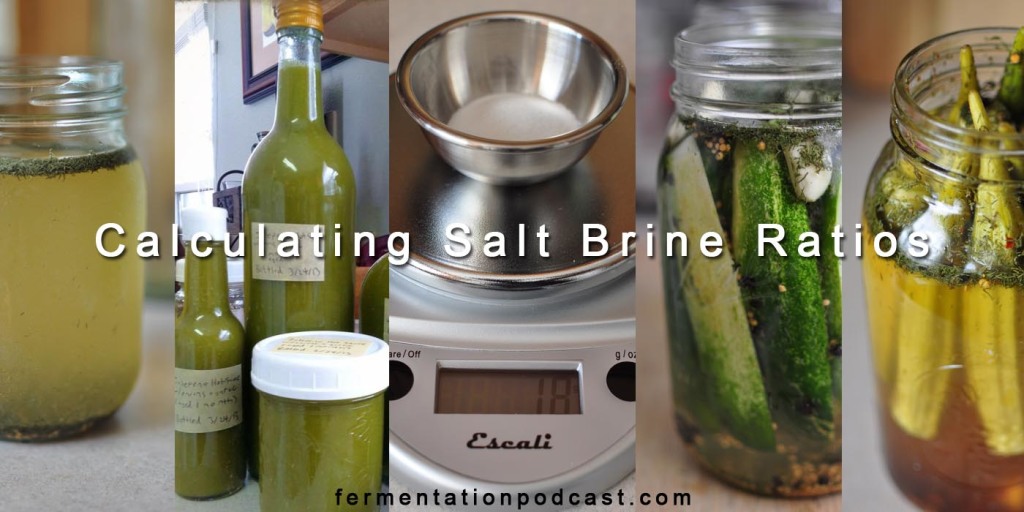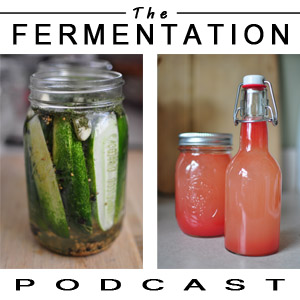DISCLOSURE: This post may contain affiliate links, meaning I get a commission if you decide to make a purchase through my links, at no cost to you. Please read my disclosure for more info.
To go along with yesterday’s podcast, Episode 10 – Types of Salt, Brine Basics, and Weight Ratios in Fermentation, I decided to do a writeup showing you how to make a salt brine for fermentation and fermented vegetables. There are several methods for creating a salt brine recipe and calculating how much salt to use, and I’ll go over the three methods I mentioned in yesterday’s show.
Don’t forget to subscribe to our YouTube channel. We appreciate your support! Here’s one of our favorite recipes:
Starting off, here’s what I was talking about when I mentioned that there are several different types of salt to consider when fermenting foods and making brines.
Types of Salt to Know for Fermentation Salt Brines
Table salt – NaCl (sodium chloride) – this is your average table salt that everyone knows that you’d have in a salt shaker at home or get at a restaurant
- it only has 2 minerals – sodium and chlorine
- it has a fine grind so smaller particles
- it also usually contains anti-caking ingredients
Iodized table salt – this is table salt that has iodine added to it along with anti-caking ingredients
- it also only has 2 minerals – sodium and chlorine
- it has a fine grind so smaller particles
- it also usually contains anti-caking ingredients
- The reason iodine was added back in the 1920’s was that people were starting to get iodine deficiencies. Iodine deficiency causes goiters, which is a swelling of your thyroid gland in your neck. Iodine deficiency was and still is a major cause of mental retardation in the world so when the government forced salt companies to include this, it actually did help alleviate the iodine deficiency problem.
- You don’t want to use iodized salt in fermentation not only because of the anti-caking ingredients, but because the iodine that’s added can react to the ferments causing dark colors.
Pickling salt – this type of salt is marketed for people making pickles and for canning
- it also only has 2 minerals – sodium and chlorine
- it has a fine grind so smaller particles
- his type of salt does not contain anti-caking ingredients so it can have a tendency to cake or clump together
- this is okay for fermentation but there are healthier salts you can use
Kosher salt – this type of salt was made for religious reasons to extract blood from meat to adhere to Jewish law
- it also only has 2 minerals – sodium and chlorine
- it has a much coarser grind so there’s larger particles
- this type of salt does not contain anti-caking ingredients but doesn’t suffer from clumping because of the coarser grind
- this is also okay for fermentation but there are healthier salts you can use
Sea salt – originates from the sea or mineralized water. This is what I prefer and no particular brand in general. Even better is iodized sea salt. Could contain 80+ more minerals than table salt but it really depends on where the sea salt was obtained and it can vary
- it usually contains several major minerals in addition to sodium and chlorine like potassium, phosphorus, calcium, sulfur
- trace minerals in sea salt can include iron, iodine, manganese, zinc, bromine, boron, copper
- two methods of making sea salt
- Mining from ancient salt beds – this method could possibly be more pure
- Evaporating mineralized water like that from the ocean, sea, lakes, or ponds – this method could possibly concentrate toxins
Fleur de sel or “flower of salt” – a type of salt that is made by evaporating sea, lake, or spring water in evaporation ponds or pans and collecting the young salt that forms on top of the water
- contains numerous minerals like any sea salt would
- can be used for fermentation, but is more expensive and probably not worth the extra cost
- better for fine cooking
Sel gris or “grey salt” also known as Celtic sea salt – it’s grey in color is harvested the in same way as Fleur de sel is by harvesting evaporated sea, lake, or spring water except sel gris is the salt that has sunk to the bottom and is then raked and collected
- contains numerous minerals like any sea salt would
- can be used for fermentation and is probably one of the more popular sea salts available
- good price for how much you get
Pink Himalayan salt – this salt is harvested in Pakistan which is part of the Himalayan mountain range and the pink color is due to the salt containing iron oxide (which is rust)
- contains numerous minerals like any sea salt would
- can be used for fermentation, but is more expensive and probably not worth the extra cost
- better for fine cooking
- probably one of the more pure salts since it’s mined from ancient sea beds
Black salt (also known as Kala Namak) – this salt is a pinkish gray and is mined in India and has a strong sulfuric smell. It’s mostly used in Southeast Asian cooking but vegan chefs have also been using it to give an eggy flavor to their cooking
- contains numerous minerals like any sea salt would
- can be used for fermentation, but is more expensive and probably not worth the extra cost
- better for fine cooking with the twist of having a sulfuric smell
- it might give ferments a strange sulfur aroma
Hawaiian sea salt – it can be fine or course and can be red or black. The red Hawaiian sea salt gets its color from a natural mineral called Alaea which is a volcanic baked red clay. The black Hawaiian sea salt gets its black color from the charcoal in it
- contains numerous minerals like any sea salt would
- can be used for fermentation, but is more expensive and probably not worth the extra cost
- better for fine cooking
Other types of salt – several other types exist like smoked salt, seasoned salt, flaked salt, just to name a few
Calculating Salinity Percentage for Brine Recipes
Calculating Salinity % by Weight
- Use a kitchen gram scale to weigh everything
- Take the weight of the water or vegetable matter (if you’re sweating vegetables like cabbage) and multiply by the % salinity you’d like
- Example 1: You need 1 cup of brine to cover your vegetables and you want a 2% salinity
- Weigh your water in grams (1 cup of water weighs about 236 grams)
- Multiply 236 x 0.02
- You need approximately 4.72 grams of salt (so you could round it down to 4 or up to 5)
- Example 2: You’re making sauerkraut and want to know how much salt you need for 1 1/2 lbs of cabbage and a 3.5% salinity
- Covert 1.5 lbs to grams which is about 680 grams
- Multiply 680 x 0.035
- You need approximately 23.8 grams of salt (so you could round it down to 23 or up to 24)
Here’s a general guide that you can use as an estimate but don’t forget! All salt weighs differently so you’ll have to experiment with this until you find what you like.
Calculating Salinity % by Volume
- Find a salt level you like per cup of water
- For example, for pickles, I like 3/4 tablespoon of salt per cup of water (this will make very salty pickles for sandwiches, you might like less)
- Scale this up for bigger batches
- Figure out what you like for other recipes, for example for pickled peppers I like 1 teaspoon per cup of water) and scale that up
- Don’t forget that different salts weigh different amounts
Calculating Salinity % by Taste Test
- Put your vegetables or whatever you’re fermenting in the jar, pour in your water, add a little salt, stir to dissolve, taste, add a little more, stir to dissolve, taste and so on.
- I preface this by saying this method is more for the safer ferments like vegetable ferments, not for riskier ferments like meats.
General Rules of Salinity Ratios
Here’s some general rules to keep in mind when you’re figuring out what salt level to use in your fermented food recipes:
- Most people like a 2-5% salinity ratio, but this depends on your tastes and how your ferment is working for you. You might like a lower or higher salt ratio so it really comes down to the taste you’re looking for.
- For softer vegetables like cucumbers, sometimes a higher salinity like 5% or above helps keep the cucumbers a little crunchier, but you can also use different leaves with tannins instead
- Once you get into other ferments like meat, different cheeses, brining olives, making fish sauce, or making a batch of miso the salt ratios can go much high like 10-20% or even more
- Keep in mind that the higher the salinity of the brine, the longer the fermentation is going to take
- Don’t forget to add herbs, spices, and aromatics like garlic. Sometimes adding more flavor means you can back off the salt
- Lemon juice also helps where you can put less salt since you’ll be starting with a brine that’s just a little higher in acid which discourages other bacteria
- And of course, when fermenting vegetables, you always want whatever you’re fermenting to be below the brine level
I hope some of this information and the salt percentage chart for brine helps. Let me know what you think in the comments below!





3 comments
Hey guys, how are you doing? My name is Igor, I’m from Brazil
I’ve made a few batches of fermented pickles ( 2ts salt per litter), and twice my cucumbers were filed with the brine, there was a huge hole inside it, had no problem with the other vegetables that were among them. I’ve also added a few spices, black pepper grains , bayleaves coriander seeds, garlic cloves, oregano, mustard seeds and chilli. Could you guys help me figure this out? Thanks!
I am shocked that you do not have a string of comments following this post. You have provided the most thorough evaluation of salinity in fermentation that I have found anywhere, from books to blogs. Thank you so much for your very thoughtful and well researched information. I am bookmarking this page to use until I have the information memorized. THANK YOU!!!
Thank you for this info!! Very helpful..it drives me crazy when i read fermenting recipes and salt weight is not used.